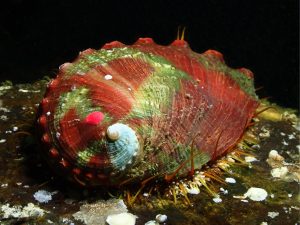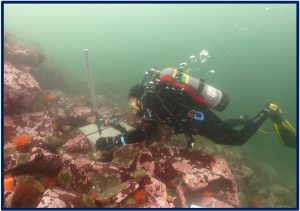New research informs future restoration efforts for endangered pinto abalone populations in the Pacific Northwest
From the Winter 2023/2024 Sea Star
By Emma Duckworth, WSG Science Communications Fellow
The pinto abalone is a crucial organism in Puget Sound. “They are the Roomba of the rocky intertidal,” says doctoral student Eileen Bates.
Abalone are key grazers that feed on the rocks of the intertidal, which allows for the natural succession of other species in the habitat and keeps the entire ecosystem in good health. Pinto abalone have historically been important to Tribes in the Pacific Northwest, acting as a food source and artistic symbol in their cultures.
However, widespread recreational harvesting of pinto abalone has contributed to heavy declines in their populations, and they landed on the endangered species list in Washington in 2019. Since their overexploitation, numerous efforts have been implemented to try to restore populations in the area through abalone hatcheries and the outplanting of juveniles. With funding from Washington Sea Grant, Bates has been working on a project led by Jacqueline Padilla-Gamiño, a professor at the University of Washington School of Aquatic and Fishery Sciences, that aims to increase the success of these restoration efforts.

An outplanted pinto abalone. Photo: Taylor Frierson.
Since 2003, the Puget Sound Restoration Fund has led multiple collaborative efforts with the Washington Department of Fish and Wildlife to help recover pinto abalone populations by rearing juveniles in hatcheries and outplanting them in the wild. There are many unknowns about rearing these animals, and survival rates once they are released in the wild are highly variable — scientists don’t know which factors give the abalone the best chance of thriving in their natural environment. Through partnering with the Puget Sound Restoration Fund, Padilla-Gamiño aims to gain insight into growing and releasing abalone, with the hopes of identifying the best conditions for future restoration efforts.
Beyond understanding how to rear pinto abalone in the hatchery or where they best thrive, restoration practitioners today need to understand how ongoing ocean change could impact their efforts. “It doesn’t matter if we can produce more, if the waters are not clean or are too acidic, the abalone just won’t survive,” Padilla-Gamiño says.
One of the main focus areas of Padilla-Gamiño’s study was investigating how variables like temperature and pH affect larval and juvenile abalone survival. Preliminary results suggest that abalone is more sensitive to pH than to temperature, which was something the research team had not previously hypothesized.
Another factor that can determine the success of pinto abalone restoration is the type of substrate used to grow the young organisms in the hatchery. Pinto abalone are broadcast spawners, which means they release sperm and eggs into the water column. Eggs are then fertilized and develop into larvae. After a short period, the larvae settle down into the rocky bottom of the water column and eventually grow into adults. In their natural habitat, pinto abalone settle on coralline algae — however, most hatcheries use a synthetic substrate called GABA for rearing juveniles. The research team utilized both coralline algae and synthetic GABA substrate in the experimental tanks to test the relative success of each strategy.
They found that hatchery tanks with the coralline substrate yielded better survival rates compared to synthetic GABA substrate, indicating that hatcheries should use coralline algae over GABA for the best results. In hatcheries today, GABA is more commonly used, as it is much easier to work with than trying to culture coralline algae. According to Bates, trying to grow coralline algae for the substrate was one of the biggest challenges of this experiment — however, perfecting this process to enable the widespread use of coralline algae as a substrate may be a key ingredient in increasing survival rates of outplanted juvenile algae.
This project is also investigating how using probiotics in abalone hatcheries affects growth and survival rates for juveniles. The use of probiotics is popular in commercial settings like oyster hatcheries to promote the growth of beneficial bacteria and discourage the survival of bad bacteria. However, probiotics haven’t been studied as much in abalone hatcheries. Bates explains that the motivation behind this focus of the project was to “harness the research going into probiotics for commercial aquaculture and apply it to conservation aquaculture.”

Doctoral student Eileen Bates installing a sensor. Photo: Katie Sowul.
Once the abalone have grown to the juvenile stage, restoration practitioners outplant the animals in the wild. But the abalone don’t always survive. As part of this project, the team is analyzing the factors that may contribute to the animals’ survival, looking at environmental conditions such as pH, dissolved oxygen and salinity in the natural environment. The researchers have studied 16 sites over three years with varying abalone survival rates. As Padilla-Gamiño explains, information from this research will give insights into where the best outplanting areas for juvenile abalone will be, now and in the future as climate change continues. ”While it’s important to know where abalone survive, it’s just as important to know where abalone cannot survive,” she says. By understanding the environmental conditions that give outplanted juveniles the best chance at survival, organizations like the Puget Sound Restoration Fund can focus efforts in the right areas and more efficiently work towards restoring populations.
As for what’s next for abalone restoration research, Bates shares that she is eager to investigate the use of probiotics in abalone hatcheries and that this pilot study is just the first of many. This work is just scratching the surface: Padilla-Gamiño explains that there is much more research to be done on pinto abalone in general. Because they aren’t commercially harvested, very little is known about their relationship with other organisms and their environment compared to shellfish species like oysters. “We still need to work a lot in the field to really understand how abalone are connected to other organisms… we need to understand the basic natural history of abalone in Washington,” she says. “We need to truly understand their ecology and their physiology.”
Partnerships between research and restoration organizations are vital to preserving endangered species like the pinto abalone. Especially in the face of a rapidly changing environment, research projects like this are key to figuring out how we can adapt and maximize restoration efforts for these organisms. Future research projects and partnerships like this one will continue to teach us more about the pinto abalone and, hopefully, one day restore wild populations.
###
Washington Sea Grant, based at the University of Washington, helps people and marine life thrive through research, technical expertise and education supporting the responsible use and conservation of coastal ecosystems. The National Sea Grant College Program is part of the National Oceanic and Atmospheric Administration, U.S. Department of Commerce.
Join the conversation: instagram.com/waseagrant and Facebook.com/WaSeaGrant.
MAR
2024